Location: Overlay Types dialog > OGC > OGC WFS
Selecting OGC WFS will display the following OGC Web Feature Services (WFS) dialog:
 dialog.gif)
Well-known servers
Select a well known OGC WFS server from the drop-down box.
Connect using SAML 2.0 ECP Profile
Check this tickbox to make connection using the OASIS Security Assertion Markup Language (SAML) version 2.0.
See http://docs.oasis-open/security/saml/v2.0 for details of (SAML) version 2.0 Profiles.
If this option is selected the Shibboleth Federation Metadata dialog will be displayed.
If this option is NOT selected the OGC Web Feature Services (WFS) dialog will be displayed, see below.
Validate XML from server
Check this tickbox if you wish the XML returned by the server in this document to be validated.
Capabilities...
Displays the XML capabilities document for the OGC WFS in the resizable HTML/XML Viewer dialog, for example:
Click OK to return to the OGC Web Feature Services (WFS) dialog.
Click Next.
The two possible dialogs are as follows:

Enter the URL of the Shibboleth Federation Metadata and click Next.
The Shibboleth Logon Details dialog will be displayed:
Identity Provider
Select the Identity Provider from the drop-down list.
User name
Type the user ID to use for authentication when you log on.
Password
Type the password to use for authentication when you log on.
Save password in Options database (encrypted)
Should SIS store the password in the Options database? The password will be stored in encrypted form for security.
Click Next.
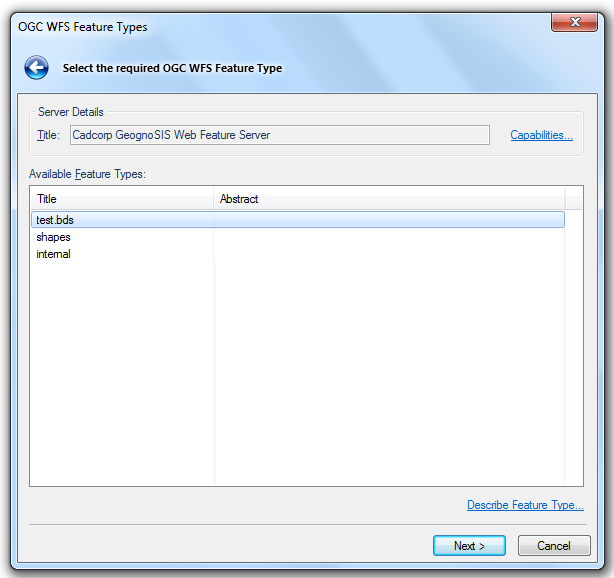
Server Details
Title
This is a descriptive title returned by the OGC WFS.
Capabilities...
Displays the XML capabilities document for the OGC WFS in the resizable HTML/XML Viewer dialog, for example:
Available Feature Types
As an example select test.bds.
Describe Feature Type...
Displays the XML description of the selected Feature Type in the resizable HTML/XML Viewer dialog, for example:
Click Next.
The OGC WFS Feature Type dialog will be displayed:
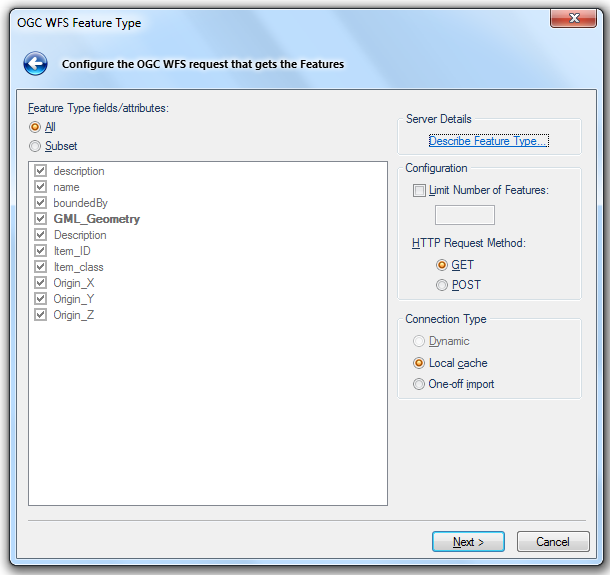
Feature Type fields/attributes
The list of available columns for the Feature Type. Select All or Subset.
Server Details
Describe Feature Type...
Displays the XML description of the selected Feature Type in the resizable HTML/XML Viewer dialog, for example:
Configuration
Limit Number of Features
If you wish to limit the number of features to be returned, check the tickbox and enter the number in the box.
HTTP Request Method
GET/POST - select the radio button for the required request method.
Connection Type
Dynamic
This option is not currently available.
Local cache
Select this option if you require SIS to download the resulting features to local temporary storage.
This connection type caches the image on the local client. The amount of memory used depends on the size of the image. Once the data is on the client SIS does not need to communicate with the server. If the overlay is saved as a part of the SWD, data will be retrieved from the server when the SWD is first opened.
One-off import
Select this option if you require SIS to make a one-off copy of the resulting features, that are completely disconnected from the OGC WFS.
This connection type caches the image on the client as a copy of the data. The SWD will not retrieve the data from the server when the SWD is subsequently opened. This connection type allows users to create a local snapshot of the data. If the data changes on the server, the user will still have a copy of the data as it was before the change was made.
Click Next.
The OGC WFS Filter dialog will be displayed:
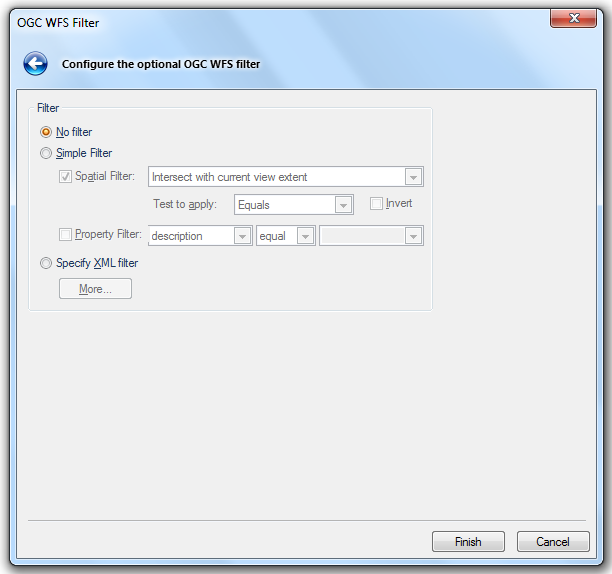
Filter
No filter
Select this option if you use no filter.
Simple filter
Select this option to give a choice of
Spatial Filter - Check this tickbox if you want to create a spatial filter.
Select either Intersect with current view extent or Test with currently selected item.
Select the type of spatial filter to apply from the drop-down box:
Equals - The Geometries are topologically equal
Disjoint - The Geometries have no point in common
Intersects - The Geometries have at least one point in common (the inverse of Disjoint)
Touches - The Geometries have at least one boundary point in common, but no interior points
Crosses - The Geometries share some but not all interior points, and the dimension of the intersection is less than that of at least one of the Geometries .
Within - Geometry A lies in the interior of Geometry B
Contains - Geometry B lies in the interior of Geometry A (the inverse of Within)
Overlaps - The Geometries share some but not all points in common, and the intersection has the same dimension as the Geometries themselves.
DWithin -
Beyond - For future use
Test to apply - Select the spatial filter operation from the drop-down box.
Invert - Check this tickbox to invert the spatial test
Property Filter - Check the tickbox if you want to specify a property ("scalar") filter
Select the required available column from the first drop-down box.
Select the scalar filter operation from the second drop-down box.
Enter the search expression for the scalar filter from the third drop-down box.
Specify XML filter - Select this option if you require an XML filter.
The More... button will display a resizeable XML Filter dialog to allow you to specify any filter.
Click Finish.
Using as an example an overlay containing roads, selected in the OGC WFS Feature Types dialog, the following displays may be obtained.
Initial display:

After Spatial Filtering with Intersect with current view extent using the Within test:
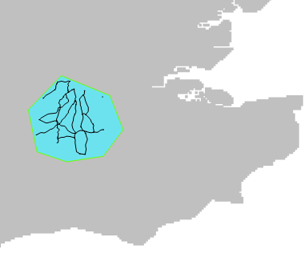
After Spatial Filtering withIntersect with current view extent using theIntersecttest:
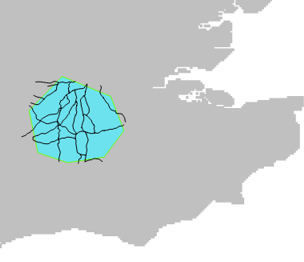
Send comments on this topic.
Click to return to www.cadcorp.com
© Copyright 2000-2017 Computer Aided Development Corporation Limited (Cadcorp).